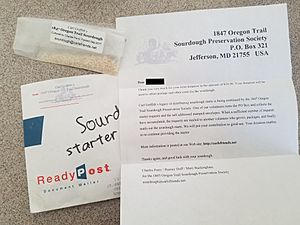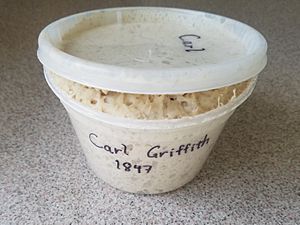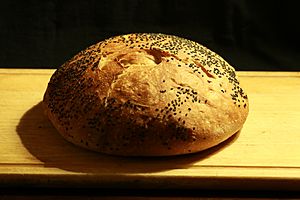Carl Griffith's sourdough starter facts for kids
Carl Griffith's sourdough starter, also known as the Oregon Trail Sourdough, is a special mix of flour and water. It contains tiny living things: wild yeast and bacteria. Bakers use this mix to make bread rise and give it a yummy, slightly sour taste. This starter has a very long history, going back to at least 1847. That's when settlers carried it along the Oregon Trail from Missouri to Oregon.
The starter was then passed down through Carl Griffith's family. In the 1990s, Carl shared it with many people online. Since 2000, a special group of volunteers has kept it alive. They feed the tiny organisms flour and water. They also mail free samples of the dried starter to anyone who asks, all over the world! This helps bakers start their own sourdough cultures.
Just like any sourdough starter, the yeasts in Carl's starter make carbon dioxide gas. This happens when they eat sugar in the bread dough. The gas gets trapped, making the dough puff up and rise. This process is called fermentation. The bacteria in the starter, called Lactobacillus, make lactic acid. This acid gives the bread its special sour flavor. Carl's starter is known for being strong and easy to use. It rises quickly and makes bread with a great taste every time.
Contents
A Long History
Carl T. Griffith said his family's sourdough started with his great-grandmother. She traveled west from Missouri on the Oregon Trail in 1847. She settled near Salem, Oregon. The sourdough starter was given to Carl Griffith when he was 10 years old, around 1930. This happened in a sheep camp. His family was building a home in the Steens Mountains at that time. Carl baked bread in a Dutch oven over a campfire. He even took his starter on cattle drives in Oregon. During these trips, he baked in chuck wagons. Carl Griffith later became a lawyer and a veteran of World War II.
Sharing on the Internet
The starter became famous in the 1990s because of the early Internet. Carl Griffith was part of an online group called rec.food.sourdough. He became known for sharing his family's sourdough starter. He would mail small amounts of dried starter to people all over the world. He only asked for money to cover the postage. He would also send family recipes and instructions. Starting a new sourdough can be hard for new bakers. So, Carl's easy-to-use and tasty sourdough became very popular.
Carl's Friends Keep It Going
Carl Griffith passed away in early 2000 when he was 80 years old. He had been living in Sequim, Washington. By then, many people knew about his generous sharing. He was getting about 100 requests each year. No one in Carl's family wanted to keep growing his sourdough. So, the online group decided to take over. A man named Dick Adams created a website and asked for volunteers. Ten friends and fans of Carl's starter formed a group. They called themselves the 1847 Oregon Trail Sourdough Starter Preservation Society. They are also known as Carl's Friends. Their goal is to keep the starter alive and share it for free.
These volunteers grow the starter and dry it into thin sheets. Then, they grind it into a coarse powder. About once a week, a volunteer mails small bags of the dried starter to people who ask for it. By 2003, they were getting up to 20 requests each week. They even had helpers in Australia and the UK. In 2019, the group had a main starter grower, a backup grower, and several people who kept the culture. To make sure the starter stays pure, these culture keepers promise not to have any other sourdough starters in their homes.
Growing Popularity Today
Over the years, more and more people have asked for the starter. The group received 2,169 requests in 2018. In 2019, they were getting 30 to 90 requests every week. The volunteer who mails the samples says their website is often mentioned in newspaper articles about sourdough bread. This makes more people want to try it. Sourdough baking has become more popular since the 1990s. Its history is part of why people like it. One baker said, "I like the idea of traditional bread, like what our great-grandmothers ate." Many starters, including Carl's, have been passed down through families for generations.
Baking sourdough doesn't need much special equipment. It uses simple ingredients. But it does take practice to get it just right. People also like that it's very natural. As one person online said, "If you take flour, water, wild yeast, and salt, and play with time and temperature, what comes out is something amazing." Many hobby bakers proudly share their creations online.
Carl's Friends have given out over 54,000 samples of Carl Griffith's sourdough starter. During the 2020 COVID-19 pandemic, many more people started baking at home. This caused requests to jump to 300 per week! It was also hard to find other things that make bread rise, like Baker's yeast, in stores. But sourdough starter can be kept and grown with just flour and water. One volunteer even gave out over 800 wet starter packets and mailed 1,400 dry ones. People lined up outside her house to get some!
What's Inside the Starter?
Scientists at North Carolina State University studied a sample of Carl Griffith's starter. It was one of 560 sourdough starters they looked at for their "Sourdough Project." They studied the unique groups of bacteria and yeasts in most of the starters. They found that Carl Griffith's starter contains Saccharomyces cerevisiae. This is one of the most common yeasts found in the 560 starters. This makes sense, as Carl's starter is very old and might be the ancestor of many others.
The bacteria in Carl Griffith's starter are mostly Lactobacillus brevis. There are also smaller amounts of eight other types of bacteria. The lactic acid these bacteria make gives the bread a less sour taste than other acids. Scientists also found two types of Streptococcus in the starter. These types are not harmful to people.
Bakers and scientists still wonder if sourdough starters change when they move to new places. Some bakers say their starters act differently after they move or take them on vacation. So, it's possible that the starter today is different from the original one from Washington. But the Society continues to share it anyway!




